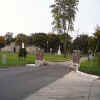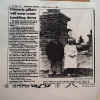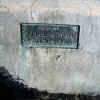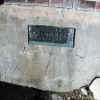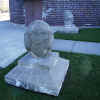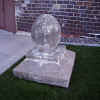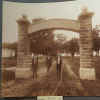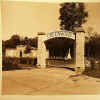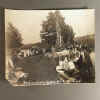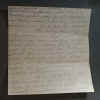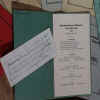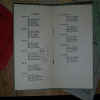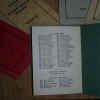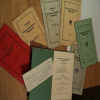| Greenwood Cemetery's principal features: the Mausoleum, Soldiers Monument,
pillars, and gates were erected in the early 20th century. The earliest known gates may be
seen in this early postcard. Today as you enter Greenwood Cemetery, by College Street,
just south of the mausoleum, you enter between two short pillars. These two short pillars
are what remains of the original pillars. They originally had an archway over them, which
had “Greenwood Cemetery” printed on it. The original pillars were put up in
1917, the same time as two pillars were installed at the south end of North College Street
and its intersection with First Street, although the latter pair did not include an
archway. The general contractor used was Earnest A. Randall. The now defunct Greenwood
Cemetery Improvement Association (discussed below) donated $600 toward the project, its
first large expenditure.[25] Earnest Randall’s son and daughter remembered the building
of the archway: After the design was finished, all the letters had to be cut from wood -
made concave to shape the protruding cement letters. When everything was spaced properly,
the whole thing was taken apart and all the wood was boiled in linseed oil so the cement
would not stick to the form. The arch was built of reinforced concrete. The balls were
made separately and hoisted into position with a block and tackle. The balls have been
removed for safety - over fifty years of weather takes a toll on even the best of
work.[26]
The balls were removed before the archway and pillars, around 1967. Note the two photos of
the archway included in this website. The pictures show the pillars before and after the
balls were removed. More than likely, the archway was taken down the same time as the
pillars at the intersection of First Street and North College Street, during the winter of
1983-84. These pillars had to be removed because they had been deemed structurally
unsound. |
|
| During Greenwood Cemetery's earlier history there were no sextons or caretakers caring
for the cemetery. The cemetery was not taken care of for a great many years. As a result
the place was full of overgrown weeds and hazel brush.[30] If someone looked for a grave, he
or she came back covered with burs and scratches.[31] Henry Feldt and George Kuehnle were
the earliest caretakers. Olaf Simonsen served for one year. The next superintendent was
Charles M. Lawrence who perhaps served longer than any one man.[32] Lawrence retired from
the job at age 78. Joe Eiler was his successor in April 1931. Since Eiler retired, Ray
Muller, Harold Dennler, and Rusty Roberts have served as superintendents. Ray Muller
started working at the cemetery in December 1968, and took over as superintendent on April
1, 1969. Muller retired in June 1973 because of ill health. Harold Dennler started working
for the City of Cedar Falls Cemeteries in May 1968, and was appointed superintendent on
June 1, 1973. Dennler retired in December 1983. Rusty Roberts started working for the
Cedar Falls Cemeteries in February 1980. He was appointed superintendent in February 1984.
Over the last 65 years, there have been a total of four superintendents of Greenwood
Cemetery. Rusty Roberts is now the superintendent of Greenwood Cemetery and two other municipal cemeteries in Cedar Falls. The city currently employs three full time employees and three seasonal employees. They remove their own snow and have all the equipment needed for digging graves in winter and summer months. As of September 28, 1998, there were 10,557 gravesites occupied or sold within Greenwood Cemetery, and 3,800 plotted but not sold. Roberts stated that Greenwood Cemetery averages around 100 burials per year. All lots in the Original Section are sold and nearly all are occupied. The last burial to take place in the Original Section was two years ago.[33] Those buried in the Original Section today usually are in older family plots purchased many years ago. Many cemeteries, including Greenwood, have been influenced by the “rural” and “lawn” cemetery movements. Joe Eiler, Rusty Roberts, the Greenwood Cemetery Improvement Association, Harold Dennler, and countless others have left their impact on Greenwood Cemetery. Every cemetery across America has a history. Greenwood Cemetery is just one of thousands of cemeteries across America with a unique and interesting past. Studying Greenwood Cemetery can help us understand the development of the American cemetery and how it fits and reflects our culture. Next time you are in a cemetery, or driving by one, stop, look around, and you may be surprised what it can tell you.
|
Endnotes 1 French, Stanley, “The Cemetery as Cultural Institution,”
ed. Stannard,
David E., 2 French, 71. 3 Cedar Falls Historical Society Archives: Series XX (Greenwood Cem-Misc.): Box
2: 4 French, 74. 5 Farrell, James J, Inventing the American Way of Death (Philadelphia: Temple
University 6 French, 70. 7 French, 70. 8 Farrell,102. 9 Farrell, 116. 10 Roberts, Rusty, Greenwood Cemetery Caretaker, Interview, September 28, 1998. 11 CFHSA: Series XX: Box 2: Folder 2. (Memo to Dick Brun). 12 Melendy, Peter, Historical Record of Cedar Falls (Cedar Falls: Peter
Melendy-Publisher, 13 CFHSA: Series XX: Box 2: Folder 2. (Memo to Dick Brun). 14 CFHSA: Series XX: Box 2: Folder 2. (Memo to Dick Brun). 15 CFHSA: Series XX: Box 2: Folder 2. (Memo to Dick Brun). 16 CFHSA: Series XX: Box 2: Folder 2. (Memo to Dick Brun). 17 Information about the history of Saint Patrick’s was obtained through the help
on the 18 Roberts, Rusty, Greenwood Cemetery Caretaker, Interview, September 28, 1998. 19 CFHSA: Series XX: Box 2: Folder 2. (Memo to Dick Brun). 20 CFHSA: Series XX: Box 2: Folder 2. (Memo to Dick Brun). 21 CFHSA: Series XX: Box 2: Folder 2. (Memo to Dick Brun). 22 CFHSA: Series XX: Box 2: Folder 2. (Memo to Dick Brun). 23 CFHSA: Series XX: Box 2: Folder 2. (Memo to Dick Brun). 24 CFHSA: Series XX: Box 2: Folder 2. (Memo to Dick Brun). 25 CFHSA: Series XX (Greenwood Cem-Misc.): Box 2: Folder 13. (Letter written by 26 CFHSA: Series XX (Greenwood Cem-Misc.): Box 2: Folder 13. (Documentation 27 CFHSA: Series XX: Box 2: Folder 13. (Wynegar Letter). 28 CFHSA: Series XX: Box 2: Folder 2. (Memo to Dick Brun). 29 CFHSA: Series XX: Box 2: Folder 13. (Wynegar Letter). 30 CFHSA: Series XX: Box 2: Folder 13. (Wynegar Letter). 31 CFHSA: Series XX: Box 2: Folder 13. (Wynegar Letter). 32 CFHSA: Series XX: Box 2: Folder 2. (Memo to Dick Brun). 33 Roberts, Rusty, Greenwood Cemetery Caretaker, Personal Interview,
September 28, 1998. Bibliography Cedar Falls Historical Society Archives: Series XX (Greenwood Cem-Misc.): Box2: CFHSA: Series XX (Greenwood Cem-Misc): Box 2: Folder 11 (Waterloo Courier article CFHSA: Series XX (Greenwood Cem-Misc): Box 2: Folder 13 (Letter written by CFHSA: Series XX (Greenwood Cem-Misc): Box 2: Folder 13 (Documentation Farrell, James J. Inventing the American Way of Death, 1830-1920. Philadelphia: French, Stanley. “The Cemetery as Cultural Institution: The Establishment of Mount
Melendy, Peter. History of Cedar Falls, 1843-1893. Cedar Falls: Peter Melendy, Publisher, 1893. Mitford, Jessica. The American Way of Death. New York: Simon and Schuster, 1963. Roberts, Rusty. Superintendent of Cemeteries, Cedar Falls, IA,
Personal Interview,
|
